The 1902 Education Act abolished the school board system and established Local Education Authorities (LEAs). Norfolk established LEAs for Norwich, Great Yarmouth, Kings Lynn and Norfolk County Council (NCC). NCC, to aid this transition; carried out a survey of its county schools in 1903. This survey is held at the NRO.
Background
This blog resulted from indexing all schools in the survey and recording all the staff who worked in them. Supporting this process another key document was used, the Salary Returns Form 2, 1903 which was completed earlier the same year (ACC 2009/304). It is useful for cross-referencing names as well as giving additional information.
The survey was completed on 30th September 1903. The schools are not always listed alphabetically but replicate the order they appear in the salary returns book. Also, some places are listed with others as one school will cover a particular district eg. Matlask is listed under Burningham.
Headteachers (HT) were asked to submit a survey for each department. Some schools submitted one form stating they were “mixed”. Others, such as Little Walsingham, submitted three; one for the boys department, one for the girls and one for the infants. For some reason there is no survey for Stow Bedon, North Lopham and South Lopham despite their appearance in the salaries book.
Content
The survey form has five different sections; details of school numbers and grant, staffing, organization of the curriculum, a plan of the school and school furniture.
The first part named the school and the HT and recorded the number of pupils, attendance and the amount of grant paid over the last three years.
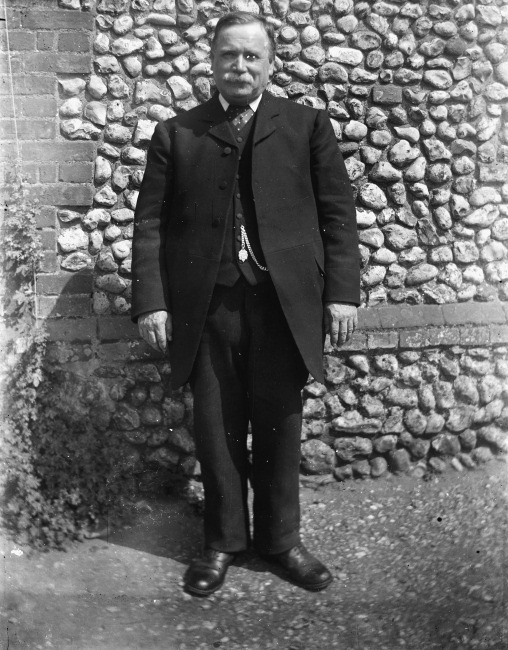
Thomas Ormond, Morley School.
(Image Courtesy of Picture Norfolk, ref. 30129028276906)

Return for Morley School
Grants were conditional upon the school being inspected. Grants could be reduced or withheld altogether eg. if registers were not kept accurately. Fulmodeston’s school log book reported in 1902 that the HT, Garibaldi Milton Crowther, was accused of falsifying the school register, an action which could have resulted in a higher than entitled grant being paid to the school. (C/ED 2/252)
Pupil numbers also give an interesting picture of the demographics at the time. Thwaite with Alby school had 61 children in 1903. Today it has no school.
The second part of the survey detailed staffing, qualifications and who taught where. Staff listed included teachers in various stages of training and monitors. Only two HTs included other staff. Eccles HT William Roberts recorded his “school cleaners & scavenger” and Walpole Cross Keys HT Sarah Earp recorded her cleaner Mrs Pitcher who was paid £4pa.
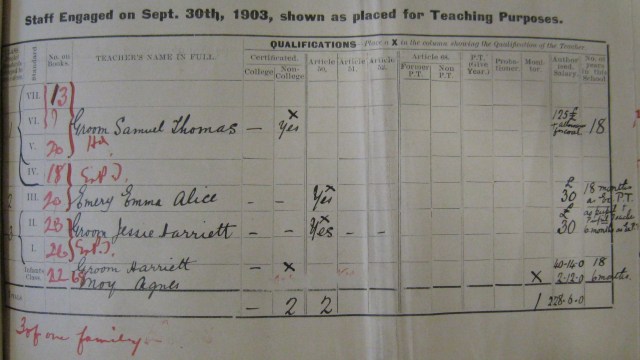
Return for Aylmerton School
At Aylmerton the infants and Standards I and II were in one class, Standard III was another class and Standards IV to VII was the third class. Individual names are not always clear particularly when the LEA has overwritten them in red. This is where Salary Return Form 2 becomes a useful cross reference.
Teachers were either certificated or uncertificated. In listing staff for the NRO index, anyone teaching other than monitors is recorded as a teacher. ‘Occasional’ teachers usually taught needlework or drill. Needlework teachers were often the HT’s wives while drill instructors came from the local community such as Sergeant Collins at Bracon Ash.
At Aylmerton school the LEA has noted that three of one family were working there. Husband and wife teams were common but there are many other examples of educational provision being a family affair such as the Beeby family at Hethersett, the Brumbley family at Long Stratton and Britiff Tidd’s family at Toft Monks and Haddiscoe. Britiff Tidd is also a good example of the social mobility of some staff being the son of an agricultural labourer.
Any concerns over staff and salaries might be recorded here. The LEA might respond accordingly with its red pen.
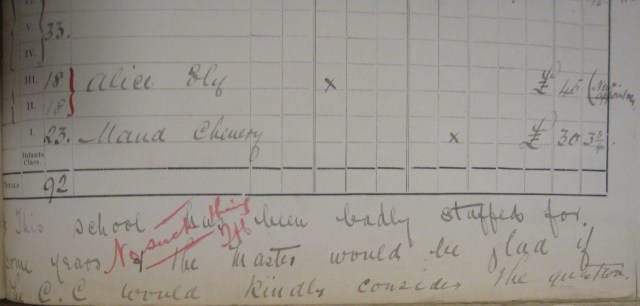
Return for Upwell St Peter School
The third part of the form is about curriculum organization. At Wreningham the HT’s wife was employed occasionally to teach needlework. Girls were generally grouped for needlework and boys for drawing.

Return for Wreningham School
The fourth part of the form asked for a rough plan of the school. The ‘rough plan’ varied enormously depending upon the type of school and the artistic efforts of the HT. The HT at Riddlesworth saw no point of drawing a plan:

Return for Riddlesworth School
A simple rectangular layout was common.

Return for Corpusty School
While at Holme-next-Runcton, HT William Barker gave a very detailed plan. Clearly his drawing lessons as a boy had served him well.
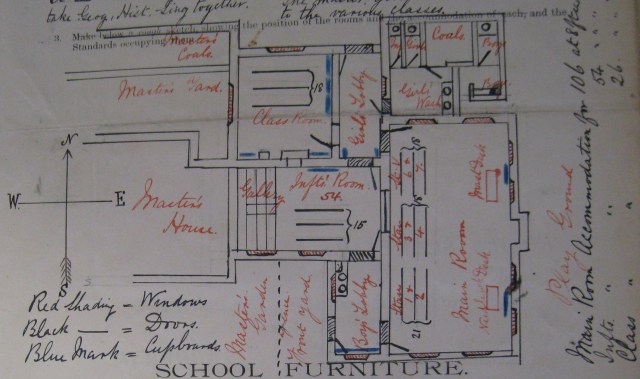
Return for Holme-next-Runcton School
The final part of the form was ‘Furniture’. If the LEA was taking on responsibility for so many schools it needed to know where money might need to be spent.
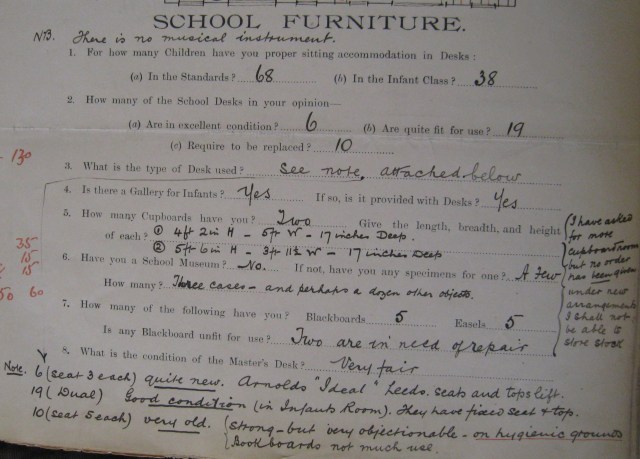
Return for Terrington St John School
Again this part of the form was an opportunity for HTs to raise concerns. At Terrington above, HT James Sparkes made the LEA aware that there was no musical instrument. Comments about desks abound, both their manufacturer and their condition. Two Norwich manufacturers, Hawes and Glendenning, supplied many schools but some desks were the joint effort of the local carpenter and blacksmith. Most desks had been around a long time so many comments were uncomplimentary; “very old and dilapidated”, “primitive and shabby”, “the desks were verbally condemned . . they have been in use since 1876”. The ‘school museum’ was a rather grand title for what was usually a cupboard storing objects for object lessons, a major part of the curriculum at the time. Where collections existed, these were often the personal possessions of the HT. Bodham school boasted one item in its museum, a tin of Fry’s cocoa while Barnham Broome had 280 objects.
The Salary Return Form which supported this research provided valuable extra information.

Salary Return Form for Dickleburgh School
The form identifies the ages of staff, their salaries, whether a school house was included (as many were for HTs) and whether staff had any other duties. School and church were often linked and many did duties such as Sunday School or were church organist; some HTs ran evening classes in the winter months.
493 pages of survey returns have the potential to reveal thousands of stories. Anyone researching education, family history or village life would find this document invaluable.
Compiled by Daryl Long, NRO Research Blogger.














Yet another source for the local historian. People often ask why I am still researching, after 42 years. This is why! New sources seem to pop up all the time and they always lead to another massive research project. 🙂
LikeLike
Thanks for your comment. This is a great resource that we have had in the Record Office since 2009 but hopefully the information will be even more accessible now our volunteer has indexed it.
LikeLike